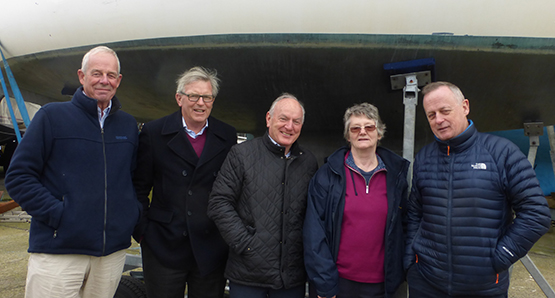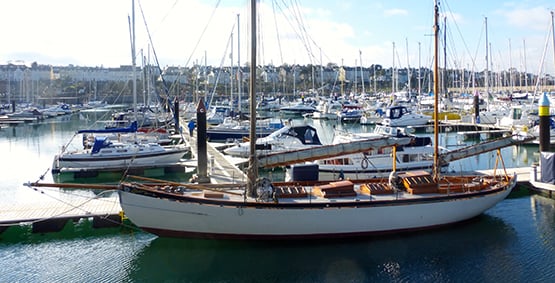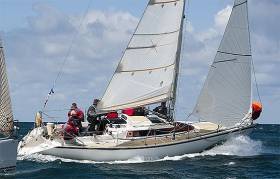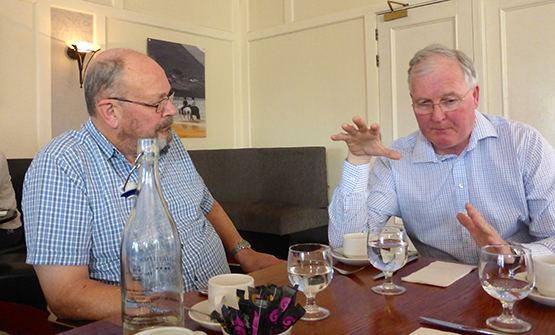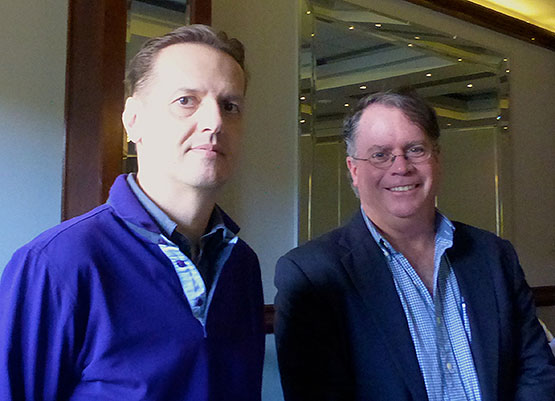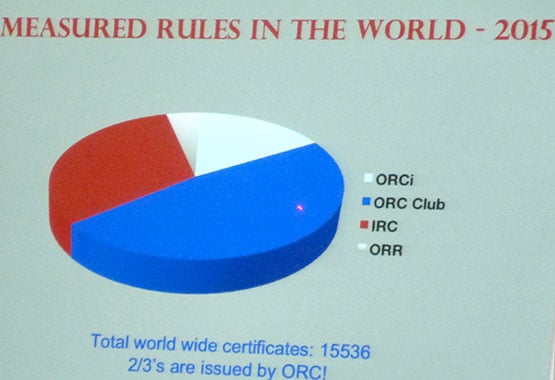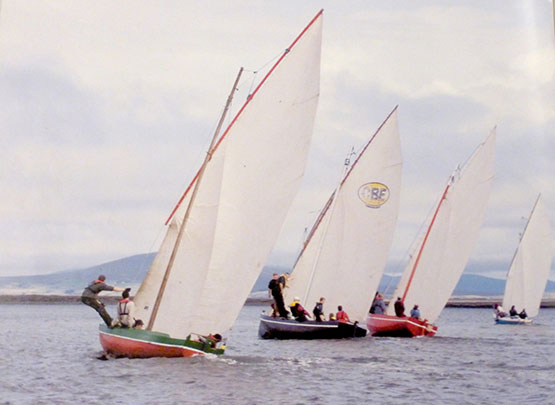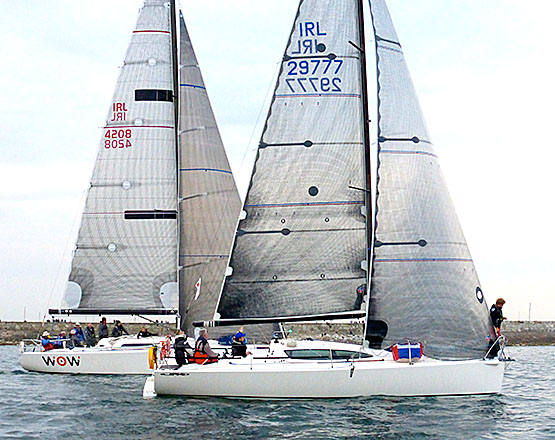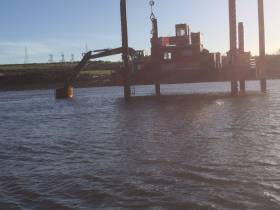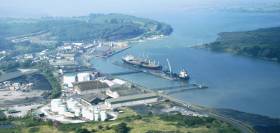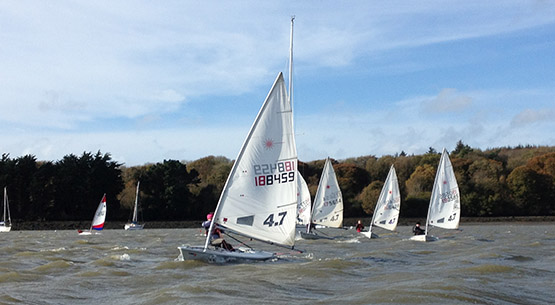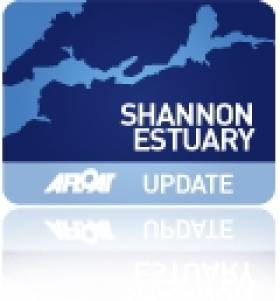Displaying items by tag: Shannon Estuary
Belfast Lough Celebrates 150 Years of Organised Sailing in Style
The development of organised sailing in Ireland seems to have spread northeastwards from the south and southwest coasts. Although the great chieftain Hugh Maguire had a fleet of pleasure vessels including sailing craft on Lough Erne in County Fermanagh in the 1500s, while the noted scientific polymath Sir William Petty found a sailing “pleasure boatte” on Dublin Bay to test his catamaran Simon & Jude against in 1663, it was on Cork Harbour that we find the first formal organisation with the foundation of the Water Club in 1720 writes W M Nixon.
Before the advent of good roads, and long before the railways arrived, Ireland’s myriad waterways and lakes provided the best options for the inland transport both of goods and people, and inevitably some gentrifried working boats were also used for relaxation, and the next club to be formed was Lough Ree YC in 1770. By 1820, the world’s first club specifically organised to provide racing came into being on Lough Erne, then nearby on Lough Gill in Sligo, the Ladies’ Cup was first raced for in 1822, and it still is cometed for today, though now at Sligo YC’s sea base at Rosses Point.
In the pre-famine era before 1845, the relative affluence of the west and southwest of Ireland supported the landed classes in yacht ownership, and a regatta at Kilrush in the Shannon Estuary in 1828 saw the establishment of the Royal Western of Ireland YC, which at its height in 1838 had a fine fleet of 18 cutters – some of quite substantial size - based in Kilrush Creek and spreading outwards to families along the coast such as the O’Connells of Tralee, Cahirsiveen and Derrynane.

The Game Changer. Dun Laoghaire’s first regatta in 1828 set Dublin Bay on course to be the pace-setter in yachting development.
But 1828 also saw the first regatta to be staged at the new harbour of Kingstown on Dublin Bay, and the success of this provided an unrivalled focus for the development of new ideas in sailing not only in Ireland, but at an international level. Whereas other sailing area saw the locations of activity spread across several centres large and small, in Dublin Bay there was just this one big powerhouse of sailing development through which all the recreational nautical energy of the capital city was channeled. The Royal Irish YC came into being in 1831, the Royal St George YC got going in 1838, and soon Kingstown outstripped most comparable centres at home and abroad, particularly in racing development.
Yet at this time Belfast was already the fastest-expanding city in Ireland, and it was moreover a growing centre of genuine wealth-creating manufacturing industries and ship-building enterprises. Why wasn’t Belfast Lough in the forefront of sailing development by the 1850s?
It wasn’t as though there wasn’t a small but time-honoured local recreational sailing tradition on Belfast Lough. During the 1780s and 1790s, Belfast had been a place of liberal ideas and social innovation, and a small group of recreational sailors led by Henry Joy McCracken pioneered cruising from Belfast Lough to the west coast of Scotland and the Hebrides. But then in 1798 McCracken also led the rising of the United Irishmen, and when it was suppressed he was executed by hanging in the Cornmarket in Belfast on land which his grandfather had donated to the town.
Subsequently, the Presbyterian majority in the north turned in on themselves and concentrated on commerce and manufacture and literally minding their own business. But though, as prosperity returned, a small group of McCracken’s former shipmates formed the Northern Yacht Club in Belfast Lough in 1824, Belfast’s rapid industrial expansion made the port very limited as a yacht harbour, thereby limiting their growth.
Belfast Lough may have provided splendid sailing water, but it was very poorly served by other smaller harbours, so the Northern Yacht Club members often found themselves sailing to the more congenial and well-serviced shores of the Firth of Clyde. They soon formed a Scottish branch, and by 1838 the Royal Northern Yacht Club - as it was to become, with an impressive clubhouse in Rothesay - had taken over the few remaining assets of the Belfast Lough branch, and that was the end of any club in the Lough for another quarter century.
Yet any student of sailing history will know that in 1856, Lord Dufferin from Clandeboye near Bangor on the shores of Belfast Lough made a celebrated voyage to the high Arctic with his schooner Foam. And in 1865, one of the most successful racing schooners of all time, the 99ft Egeria, was built for leading Belfast linen manufacturing magnate John Mulholland. So why wasn’t Belfast Lough sharing the sailing fame of other Irish centres such as Dublin Bay and Cork Harbour, which had shown their pre-eminence by staging the world’s first recognisably modern offshore race from Dublin Bay to Cork Harbour in 1860?
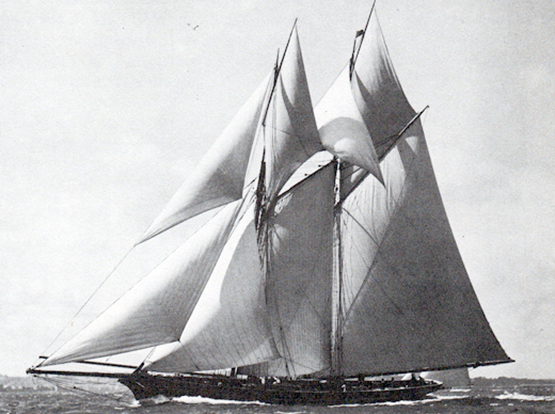
The extremely successful racing schooner Egeria was built for Belfast business magnate John Mulholland in 1865, but she was seldom if ever in Belfast Lough
The simple answer seems to be that in its period of hyper-growth, the business of Belfast was business, and sailing for recreation was not a Belfast business. Those who expected to sail at the highest level did so elsewhere, and once the Belfast to Dublin railway had been connected in 1855, it was as handy for the more affluent would-be yachtsmen to avail of the proper facilities in Dublin Bay rather than risk their yachts on exposed moorings in Belfast Lough, where shore facilities were still woefully lacking.
But in time the rapid rise of an energetic middle class in Belfast saw increasing demand for sailing amenities and events nearer home. We know that a regatta of some sort was staged at Holywood immediately east of Belfast on the lough’s south shore in 1854, and it was at Holywood – despite the little town’s drying anchorage – that the first club since the Northern YC in 1824, the Hoywood Yacht Club – was formed in 1862, and it still exists, Belfast Lough’s senior club.
Then in 1866 a regatta was staged from the only half decent harbour on the lough, at Carrickfergus, and the organisers were pleasantly surprised by the number of boats which turned out, boats whose owners had squirrelled out bits of shelter for their craft in small places like Donaghadee, Groomsport, the tiny drying harbour at Bangor, in the open roadstead off Cultra, in the cleaner parts of Belfast docks, in Carrickfergus itself, and round the corner in Larne Lough.
From this there immediately emerged the Carrickfergus Amateur Rowing & Sailing Club, but mostly to cater for local demand. But soon afterwards in Belfast the Ulster Yacht Club was formed by a group of affluent businessmen, professionals, industrialists and landowners with Lord Dufferin as their Commodore. By 1869 he’d seen to it that they’d become the Royal Ulster Yacht Club, but it was an organisation which was resolutely to function without a clubhouse until 1899, nevertheless growing in prestige with every passing year.
Thanks to that focus of interest through the Carrickfergus Regatta of 1866, 2016 will see double celebrations on Belfast Lough with the 150th Anniversaries of both Carrickfergus Amateur Rowing and Sailing Club (which everyone knows as Carrick Sailing Club), and the Royal Ulster Yacht Club, which since April 1899 has been based in an impressive Arts & Crafts clubhouse on an eminence above Bangor’s waterfront.

The RUYC clubhouse was built in 18 months and opened in 1899 in order to be ready for Thomas Lipton’s first America’s Cup campaign
When the clubhouse was built, the harbour at Bangor was still rudimentary, but the sailing was great. However, since 1984 Bangor Bay has been turned into one of Ireland’s largest marinas, and now RUYC has the berthing facilities and the sailing water to stage major events with confidence.

Befast Lough provides excellent sailing water, but until the marina were built at Carrickfergus and Bangor, it lacked sheltered berthing

Carrickfergus Marina, with the harbour and its famous 12th Century castle beyond
Equally at Carrickfergus they also have a marina – in fact it pre-dates the one at Bangor – but as Carrickfergus was also the base of the extraordinarily productive yachtbuilder John Hilditch, albeit only from 1889 to 1913, one of the main parts of their celebration is going to be a Hilditch Regatta, not just for boats built by him such as Hal Sisk’s famous 1894 Watson cutter Peggy Bawn, the Howth 17s of 1898, and the RNIYC Fairy Class of 1901, but indeed for any classic or traditional craft, as Carrick has always been a spiritual home for the Old Gaffers Association.

Bangor Marina, with Ballyholme Bay beyond
Royal Ulster has meanwhile taken a different track through sailing history, for between 1899 and 1931, it was the club through which Thomas Lipton made his five America’s Cup Challenges, which has tended to obscure the fact that in the 1880s and 1890s, Belfast Lough with RUYC in a key role were setting a fantastic pace in sailing development, as they were trying to get a one design keelboat class going as long ago as 1889, and by 1895 they’d brought the Belfast Lough One Design Association into being with a determined young sailing man called James Craig as Honorary Secretary. Membership of the BLODA was open to any member of one of the recognised six clubs now based round the lough, but young Craig – who later went on to become Lord Craigavon, first Prime Minister of Northern Ireland in 1921 – was realistic in his expectations for the life of a strict one design keelboat class, and he only expected his members to be “in class” for three seasons.
By 1896 they’d the first two boats of a new 15ft LWL keelboat class designed by William Fife, no less, sailing on Belfast Lough, and before the summer was out the signs were good for a significant increase in numbers for 1897. James Craig was insisting the boats be built by John Hilditch, as he was noted for sticking strictly to the plans as drawn by the designer, whereas the builder of the first two boats for 1896, Paddy McKeown in the heart of Belfast, was always trying to improve on the designs, even if they were from Fife.

Regatta day for the Dublin Bay 25s – their design was inspired by the Befast Lough Class I boats.
But events overtook the programme. A group of affluent Belfast Lough movers and shakers decided they certainly wanted a One-Design class to the Belfast Lough ODA rules and designed by William Fife, but they wanted a proper sea-going boats with a cabin, around 37ft in hull overall length, and 25ft on the waterline, and setting a proper gaff rig with a jackard topsail rather than the modest little gunter rig set by the 15ft LWL boats, which were still referred to as Class I.
But as the idea for the bigger boats gained traction, they became Class I, and for a while the 15ft LWL boats became Class II, but after 1900 they were Class III when a 20ft LWL class came along. But meanwhile in late 1896 and early 1897, the Hilditch yard went mad, building nine of the new 25ft LWL boats. Even Lord Dufferin and his friends Lord de Ros and Lord Bangor came round from County Down in April 1897 to the tough town of Carrickfergus to see this remarkable new class of boats being built. And once the 25 footer had their first race off Carrickfergus on May 29th , they swung into action with what today would be called a series of promotional tours, as they did all of Clyde Fortnight after a stormy crossing of the North Channel, and then after being back in Belfast Lough for long enough to race the RUYC regatta, they headed south to Dublin Bay in late July and inspired the creation of the Dublin Bay 25 class.
1898 was when they were in their prime, and by 1899 some owners were aready invoking the “three season” rule to move on, but in fact the class continued to race actively – though sometimes with very depleted numbers – on Belfast Lough until the end of the 1909 season.

John Hilditch was very busy in 1897 – in addition to the Belfast Lough Class I boats, his yard also built this 56ft motoryacht Romance for A J Lepper, for whom he’d built Peggy Bawn in 1894.
We get some idea of the boat-building pace around Carrickfergus in the late 1890s when we realise that in 1897 John Hilditch and his men were also building a 57ft Dixon Kemp motor-yacht, the Romance, for A J Lepper, for whom they’d built Peggy Bawn so well in 1894, and no sooner was the Romance out of the way than they turned to the next job, the building of the first five Howth 17s which their owners were able to sail the 90 miles to their home port in April 1898.
So obviously there’s going to be quite a complicated programme around Belfast Lough in late June and early July this year. And as the Howth 17s are in the unique position of being a Hilditch class which is not Belfast Lough-based, they hope to be able to pay their respects at Carickfergus both to the memory of their builder and to the 150th Anniversary of the Carrickfergus club, while also being able to do full justice to the Classic One Designs Regatta, which RUYC will be staging from Friday June 24th to Sunday June 26th.
The Hilditch Regatta meanwhile is from the evening of Wednesday June 22nd to Saturday June 23rd, when the fleet heads from Carrickferus to Bangor for a sail-past as part of the Royal Ulster events, but with some of the Old Gaffers then returning to Carrick (after due celebrations in Bangor) as the Carrick event is seen partially as a follow-on to the Portaferry Sails & Sounds the previous weekend, which is very much an Old Gaffers event.
In Carrickfergus are (left to right) Nick Massey, Roddy Cooper, Tom Houlihan, CSC Commodore Wendy Moore, and Ian Malcolm. Photo: W M Nixon
But for classes like the Howth 17s, despite their antiquity proper racing is what it’s all about, so I tagged along with a reconnaissance group of Howth 17 eminences when they went up North to suss out the scene this week. And as the group included Nick Massey who re-energised the class when it was going through a flakey period in 1972, Ian Malcolm who is playing a key role in the class’s current revival such that they’ll have eighteen boats racing this year, Roddy Cooper who owns the Hilditch-built Leila, and Class Captain Dr Tom Houlihan, you can be quite sure there wasn’t a dull moment.
First call was with Wendy Moore at Carrickfergus, where she’s Commodore for the 150th as the club settle into the new clubhouse after a disastrous fire three years ago, and as she’s also the Marina/Boatyard Manager and the newest addition to the ranks of owners in the local thriving Ruffian 23 class, everyone was on the same wavelength.

You’ll always find it’s now in a carpark….Roddy Cooper and Ian Malcolm stand on the spot where their Howth 17s Leila and Aura were built in 1898, with Carrickfergus Castle in the background. Photo: W M Nixon
Then we swung by Royal North of Ireland Yacht Club at Cultra on the south shore of the lough, home to the Hilditch-built Fairy class against whom the Howth crowd regularly have inter-club races, and fortuitously met up with Northern Ireland Old Gaffers Association Chairman Gary Lyons for some very high-powered info exchange. As a result we round out this week’s blog with a photo which does justice to the Portaferry Sails & Sounds which he is organising in June.
Then on in haste for a sailing business lunch (delicious) at Royal Ulster YC with Vice Commodore Myles Lindsay, Rear Commodore Greg Taylor, Honorary Sailing Secretary Robin McKelvey and Press Officer Fiona Hicks, learning yet again that the RUYC clubhouse is such a store of sailing memorabilia that it’s a difffcult to concentrate on the formal agenda, but I think the Howth men and the Bangor men understood each other very well indeed.

Myles Lindsay, Vice Commodore RUYC
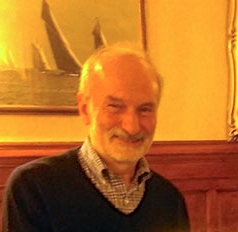
Robin McKelvey, Honorary Sailing Secretary RUYC
The RUYC people have a lot on their plate, for no sooner is the Classics Regatta out of the way than they gear up at the beginning of July for an assembly in Bangor of cruising boats from the ICC, the RCC, the OCC, the CCC and other associated organisations, followed by a 150th Anniversary Cruise-in-Company along the Antrim coast and on to the West Coast of Scotland and the Hebrides.
But for the recce group from Howth, now it was down to Bangor Marina where manager Kevin Baird couldn’t have been more obliging, but the Howth 17 men all fell in love with the classic ketch Morna berthed right next to the marina office, so Fiona and I had to speed them on their way to the exhibition of 150 Years of sailing in Bangor Museum.
The classic ketch Morna in Bangor Marina. Photo: W M Nixon
And then after that, duty done and work completed, I took them for the treat of the day, down among the hidden places of Strangford Lough to meet up with Kenny Smyth at his boatyard, which for any one who is into classic, vintage or traditional boats is heaven on earth. And of course it emerged that Kenny the King of the River Class, Whiterock’s historic Mylne-designed premier fleet, has recently become Commodore of Strangford Lough Yacht Club. So we headed for home into a gorgeous sunset having notched up two Commodores, one Vice Commodore, one Rear Commodore, one Chairman, one Honorary Sailing Secretary, two Marina Managers and one Press Officer. And if that’s not a good day’s work on the diplomacy and negotiating front, then I don’t know what is.
The eternal enthusiast. Kenny Smyth of Whiterock runs a boatyard, he is also Commodore of Strangford Lough Yacht Club, he is River Class champion, and he just loves talking about boats night and day. Photo: W M Nixon
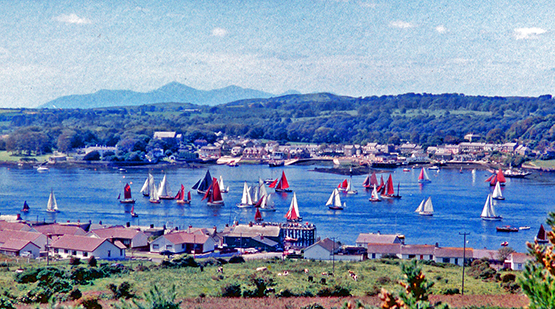
The promise of summer – the classic and traditional season in the north starts with Portaferry Sails and Sounds on June 16th.
The Irish Cruiser-Racer Association (ICRA) is a unique organisation. “Run by sailors for sailors”, it is nevertheless a very land-centric administrative body whose only manifestation afloat as a group with its own identity is seen at the organisation of the annual ICRA Nationals. And the sense of it relating purely to the island of Ireland is accentuated by the fact that much of its work is essentially back-office activity, dealing with handicaps and all the other paraphernalia involved in providing the nation’s numerous and very diverse cruiser-racer fleet with meaningful racing. W M Nixon went to last Saturday’s ICRA Conference to get a flavour of what ICRA does, and came away both impressed and stimulated.
Sweeping along southwestward towards Limerick on our wonderful motorway system, while one’s body stays firmly on the dual carriageway, the mind can wander into any pathways it wishes. So we got to thinking that, in this age of increasing numbers of administrators trained to third level degrees in the running of not-for-profit organisations, it’s a bit odd to find a very successfully central organisation which is apparently run – and well run at that - on a Corinthian basis “by sailors for sailors”.
Surely in today’s climate, which favours key bodies such as this being run by highly-trained specialists on at least a semi-professional basis, a seemingly amorphous organisation which is “run by sailors for sailors” is verging on a clear case of the asylum being taken over by the lunatics?
We’d soon see. Meanwhile, why on earth hold an annual conference in Limerick? With Ireland’s population distribution changing so rapidly, skewing both towards the large urban centres and particularly towards the east coast and Dublin, surely anyone organising a national conference would find it attendee-friendly to look at the latest map of population weighting. As it happens, I’m not sure that such a map exists, but we’d like to think that with today’s computers it is possible to construct a map where, after due calculation, you could pinpoint to the exact centre of Ireland’s total population distribution.
So you set out heading for Limerick at an unfeasibly early hour thinking that maybe a central location such as pretty Portlaoise or tidy Trim would probably be Ireland’s central point in relation to population distribution. But after some smooth time on the road with the sense of the wonderful west coast coming ever nearer, you begin to wonder why ICRA didn’t make a proper job of it, and take us to Dingle where we can breathe that wonderful Atlantic air and think great thoughts of sailing the high seas.

Far from the pressures of the cities of the east and south coasts, Dis-a-Ray is moored in the peaceful surroundings of Tarbert, where the south shore of the Shannon Estuary has already become part of the Kingdom of Kerry. Photo: W M Nixon
As it is, though the Dubs may think of Limerick as being on the western seaboard, it’s actually remarkably central when you draw lines across Ireland between all the best sailing locations. And as we knew that the position of Commodore of ICRA was going to pass on Saturday from Nobby Reilly of Howth (the Dingle of the East Coast) to Simon McGibney, Limerick was just about spot on in terms of equal travel time. For although the new Commodore has Foynes YC on the Shannon Estuary as his home club, his Dehler 101 Dis-a-ray is actually moored at his home at Tarbert which is further west down the Estuary, so much so that Tarbert is in the Kingdom of Kerry.
We arrived in to find a virtually full house distributed around a room-circling table such as they use for international diplomatic conferences to make peace with rogue states, with the layout being planned so that everyone can be an equal participant. It was grand for those of us who had arrived in the nick of time to get a seat, as we’d the fully-equipped table in front of us (did anybody else find it the devil’s own job to open the rather good but tightly-wrapped little sucky sweets which are essential to a talking shop?), but being Ireland several people arrived late, the show was already on the road, and they’d to find a seat as best they could.
All of which meant that there was a bigger turnout than expected, which is good news for ICRA. And for those of us comfortably ensconced, it made for a fascinating throughput of information by a long list of speakers, even though the layout meant that networking was restricted to the one hour lunch break if - like many people - you were relying on the 3.30-3.45pm wrap-up to facilitate returning to Dublin or Cork or wherever for a completely different event that night.
From the beginning, the dominant theme was on how we get more people into sailing, and everyone blithely talked as though we’re offering Joe Public a warm and sunny Croatian sailing product right here in Ireland, cheerfully ignoring the fact the last two summers have been plain lousy in terms of good weather.
Certainly the sailing was great for the enthusiast, but can you imagine a newcomer to the rough and ready sailing world wondering where on earth the attraction of it all was to be found as they were blown and bashed around at what we thought of as the utterly wonderful ICRA Nationals at Kinsale in June, or took in the all-too-typical variety of Irish summer weather at the hugely successful Volvo Dun Laoghaire Regatta in Dublin Bay in July?
Yet there is a fresh demand out there, and two of the morning’s speakers, Alistair Rumball of the Irish National Sailing School in Dun Laoghaire and Des McWilliam of McWilliam Sailmakers in Crosshaven, gave excellent talks on encouraging it, with Alistair showing us how his programme of moving beginners through dinghies and on into the school/club’s1720s, then became an inevitable progression into gaining experience and instruction on the school’s Prima 38 Lynx.
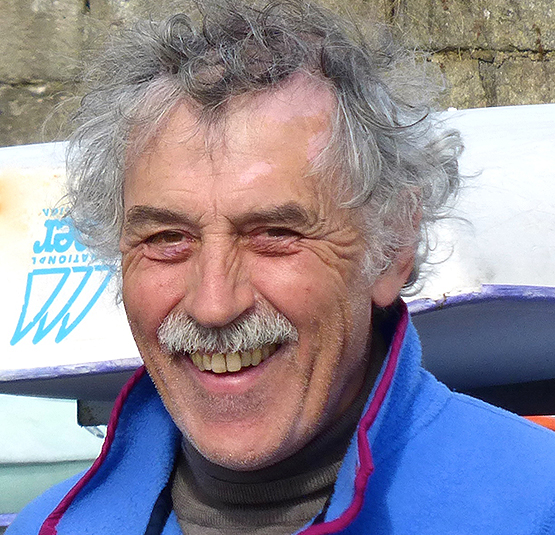 The mover and shaker. Alistair Rumball’s Irish National Sailing School in Dun Laoghaire is first port of call for many newcomers to sailing. Photo: W M Nixon
The mover and shaker. Alistair Rumball’s Irish National Sailing School in Dun Laoghaire is first port of call for many newcomers to sailing. Photo: W M Nixon
“Lynx has been a greater success than we could have ever dreamed of” he said. “She has been so booked out with people keen to learn about sailing a cruiser-racer that we haven’t been able to get as much actual racing with ISORA and so forth as we’d like. But for 2016, she’s being taken out of our Dun Laoghaire setup for long enough to be organised for a proper shot at the Volvo Round Ireland”.
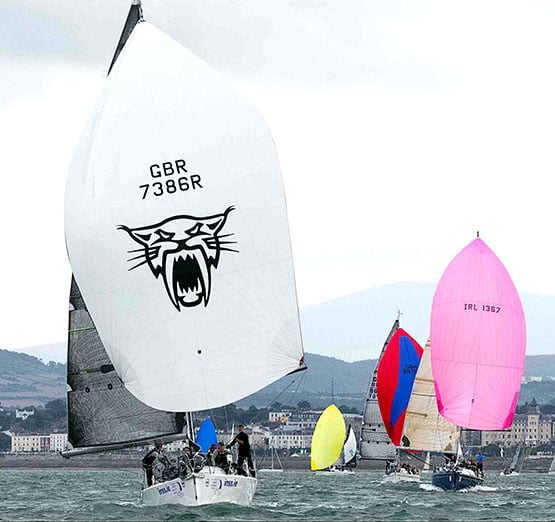
The double life of a Prima 38. The INSS’s Lynx in full racing mode in Dublin Bay (above), while below she is seen in early training mode as she takes a crew of beginners in cruiser-racing out for some formative experiences

As of last weekend in Limerick, there were just two crew places left aboard Lynx for this year’s Volvo Round Ireland on June 18th, and they’ve probably been snapped up by now. But the Rumball presentation underlined the fact that there are people out there who are mad keen to get into cruiser-racing, and it was up to ICRA to guide its members as to how best to tap into these wannabee sailors, instead of bleating all the time about how hard it is to find crew.
Des McWilliam leapt into the same theme, and gave us a crash course in how to make crewing on your boat more attractive to strangers. Admittedly the experience of seven years of acute economic recession have understandably made those who have kept boats in racing commission more than a little stressed. But if they want to reap the benefits of having struggled to stay in the boat-owning stream, then they have to make their cruiser-racers pleasanter to sail on, and more effective racing machines.
The McWilliam message was blunt in the extreme. “As a sailmaker in Ireland, each year I will race actively at many venues on upwards of 40 boats, both evenings and weekends. I will experience many different management and sailing styles. At the end of the year looking back, I usually realise that there might be only ten to a dozen boats out of that total of forty to which I would gladly and freely return for the good sport, the efficient sailing, the successful racing, the camaraderie – the fun. The rest of them are just work, involving duty visits. Please remember this when you are setting up the running of your boat, and trying to encourage people to sail with you.”
Des McWilliam of Crosshaven and Rory Staunton of Mayo. Des provided the meeting with some telling home truths about how attractive (or not) cruiser-racers throughout Ireland can be to sail on, while Rory Staunton led the charge in wondering why ORC and IRC cannot be amalgamated, and then went on to outline a new trailerable 33-footer he and an international group of friends are developing to make the incomparable west of Ireland a more accessible sailing area
We earned our lunch by going through an intensive session with Dobbs Davis of the Offshore Racing Congress, who had come to the conference with Zoran Grubisa to promote their measurement rule, which is used worldwide anywhere that IRC is not dominant, and in some key events such as the Rolex Sydney-Hobart Race, they are used in tandem, though IRC is currently the more-used system in that classic event.
It says everything about how Irish sailing punches way above its weight that these two guys thought it worth their while to come among us and evangelise for their system in a country which has a more-than-friendly relationship with the IRC and the people who run it. But it was fascinating stuff, making an input which added real spice to the day.
Davis is Chairman of the ORC’s Promotion & Development Committee, while Grubisa heads the Rating Officers Committee, and they run a system which is now the ISAF-approved rating method for the ISAF Offshore Worlds, which this year will be staged in Copenhagen in July, which as it happens is more or less the same time as the Royal Cork YC will be staging the new European IRC Championship in Volvo Cork Week at Crosshaven.
So the presence of the evangelists from the ORC at the ICRA conference could have opened up a right can of worms, but fair play to Dobbs Davis, he gave such an enthusiastic and lucid explanation of the completely transparent way in which ORC function that, for the time being at least, one’s instinctive loyalty to IRC was suspended out of intellectual curiosity.
Leading Offshore Racing Congress officers Zoran Grubisa (left) and Dobbs Davis were in Limerick to evangelise for the ORC Rating system
While IRC still has one or two hidden elements – the “Black Box” factor – with the transparency of ORC, you can always see how different inputs are effecting the final figure. One-design sailors may find all this utterly yawn-making, but as Davis pointed out, although there are so many successful cruiser-racer One-Design classes in America that ORC has yet to gain significant traction there despite being first set up in the US forty years ago, elsewhere in the world more and more people are coming to ORC as they enjoy watching boat innovation and performance analysis interacting to make their sailing more interesting and the results indicative of pure sailing ability.
The approachability of the ORC system was presented as one of its advantages
The slice of the cake worldwide for the different rating systems
But as we all know, where IRC and OCR are run side-by-side, despite the IRC’s hidden elements the two outcomes are often very similar. And in Ireland where we have a soft spot for the old S&3 34s which set world alight in 1969-73, the fact that the veteran though beautifully restored S&S 34 Quikpoint Azzura was overall winner of the Rolex-Sydney Hobart Race under OCR, after so nearly doing it on IRC, caused a bit of heart-searching. But nevertheless Rory Staunton from Mayo SC spoke for many when he demanded to know why IRC and ORC couldn’t get together and resolve their small differences for the general benefit of the offshore racing fraternity. Dobbs Davis said his door was always open, but that began to feel a bit too reminiscent of the current efforts to form a government, so we were glad enough to take a break for lunch and then return to the rating topic, but from an entirely different point of view
The inevitable expense in maximizing your boat’s performance potential under either IRC or ORC made the sheer economy of ICRA’s Progressive ECHO system seem immediately attractive, and the lead-in the afternoon session by SCORA Commodore Ronan Enright even more apposite. Because the fact is, you could run the Progressive ECHO Handicap System without even knowing what a boat looks like, let alone having her dimensions measured do the last millimtre.
Donal O’Sullivan of Dublin Bay SC, and Ronan Enright, Commodore SCORA, discussing sailing administration matters during the lunch break at Limerick. Enright went on to give an illuminating presentation about developments in Progressive ECHO Photo: W M Nixon
In the absence of ICRA’s ECHO supremo Denis Kiely - unavoidably absent for family reasons – Ronan Enright gave a quietly telling performance. It’s fascinating that though ECHO started life as the East Coast Handicap Organisation back around 1971-72, it’s now a nationwide service overseen by ICRA, and its most active area of development is in the cauldron of concentrated cruiser-racing which you find when the activities of Cork Habour and Kinsale are combined.
Basically, Progressive ECHO depends on the results of the most recent race, after which, if certain criteria have been fulfilled, the results are automatically re-computed to give boats a new rating based the supposition that they had all finished dead level on handicapped time. My own most recent experience of racing with it when it is being enthusiastically applied was in the Volvo Dun Laoghaire Regatta, which was a perfect test-bed for the system, as it was a compact series with the same fleet throughout.
The result is a series-long level of commitment by boats and crews who, under a more brutal system, would have seen their interest and enthusiasm flag after Day Two or even earlier. So really the message is: If we’re trying to get people to enjoy sailing and particularly to enjoy racing which is what the non-involved most easily comprehend, then Progressive ECHO is doing more to get bums on boats than anything else in Irish sailing, for believe me you have never seen anything quite so heart-warming as the response of a crew who, under One-Design or fixed handicap systems, had not been at the races at all, yet suddenly under Progressive ECHO they find they’ve recorded a win.
Which was all good news but perhaps the most interesting revelation of all from Ronan Enright was that the top IRC racers around Cork are now taking a closer interest in their Progressive ECHO showing than there are in their IRC results. For under IRC, they know they’ll be in the top six, but each post-race adjustment of Progressive ECHO gives them a very clear message about just how well or not they were really doing on the day.
Tom MacSweeney of this parish then hosted a forum which basically came down to how sailing can present a more friendly and accessible response to people who might be vaguely interested, and could be potential sailing enthusiasts. This involved him drawing on his training as a critical journalist, for as he admitted, when he first turned up with his first sailing boat – a Ruffian 23 – in Crosshaven, everyone from Denis Doyle downwards immediately made him welcome. But we can all think of non-assertive characters who are great sailors, yet if they hadn’t been in sailing families in the first place, they might not have taken up the sport at all owing to the sometime apparently closed nature of “yachting”.
We learned that very little of an Achill yawl is showing above the water after she capsizes. This is how they look in proper order
Allied to Des McWilliam’s incisive look at boats which you like to be aboard, and boats which you definitely don’t, and it all provided food for thought, as too did John Leech of Irish Water Safety with his no-nonsense presentation about a mature approach both to safety, and to being rescued. In an interesting mix of images, he showed us a photo of what happens to an Achill yawl when it capsizes. The result is an awful lot of rather waterlogged traditional boat under the surface, and only a little bit showing with the crew perched on top. As Des McWilliam was probably the only other person present with any idea of what an Schill yawl in full health looks like, the least we can do here is show you a photo of them in good sailing order. Meanwhile, John Leech concluded by saying that when you call out the ASR helicopters, think rather of how you can prevent your mast – if it’s still standing – from interfering with the rescue. Don’t for heaven’s sake use up emotional energy thinking about how much it all costs. They’re on standby all the time, and you the taxpayer have paid for them in the first place.
We concluded with Rory Staunton seeking interest and opinions for the new 33ft trailerable One-Design. While we all hope to get down to Clew Bay to sail the prototype this summer, could I suggest that one of the most exciting projects on the Irish cruiser-racer horizon is WIORA Week 2017 in the Aran Islands. So when they’ve finally got around to fixing a date, maybe the promoters of the new 33-footers could arrange to have a flotilla of them in Kilronan in 2017 to give the class a rocket-assisted launching.
Meanwhile this year’s WIORA West Coast Championship is under the auspices of the Royal Western of Ireland Yacht Club at Kilrush from June 29th to July 2nd. There’s so much extraordinary history in being able to write that simple bit of information that I reckon we’ll have to give it a complete blog in the future.
As for the ICRA Nationals, they’re at Howth from June 10th to 12th with both IRC and Progressive ECHO being used, while Volvo Cork Week comes up in July after the Volvo Round Ireland race has been tidied away in late June.
Although last Saturday’s Limerick gathering was essentially a wide-ranging conference, it was also the changeover to the new Commodore, with Simon McGibney taking on the mantle from the energetic and enthusiastic Nobby Reilly whose own boat, the Mills 36 Crazy Horse, was seen in virtually every event, and looked like heading for the win in Class at the ICRA Nats in Kinsale last June until new big winds swept George Sisk’s WOW to the fore. During Nobby’s busy time in the top office, ICRA’s activities and its reach steadily expand, while thanks to the persuasive efforts of Anthony O’Leary, a Commodore’s Cup team was assembled which regained the trophy in 2014.
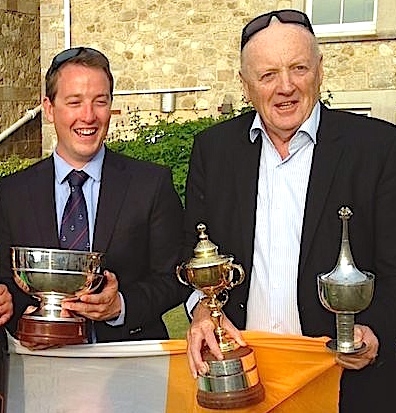 Ross MacDonald and ICRA Commodore Nobby Reilly at the Royal Yacht Squadron in Cowes in July 2014 after Ireland had won the Commodore’s Cup. At the ICRA Conference in Limerick last weekend, McDonald won a special award for his season’s results in 2015 with his X332 Equinox, while Nobby Reilly stood down after his successful years as Commodore, handing over the helm to Simon McGibney.
Ross MacDonald and ICRA Commodore Nobby Reilly at the Royal Yacht Squadron in Cowes in July 2014 after Ireland had won the Commodore’s Cup. At the ICRA Conference in Limerick last weekend, McDonald won a special award for his season’s results in 2015 with his X332 Equinox, while Nobby Reilly stood down after his successful years as Commodore, handing over the helm to Simon McGibney.
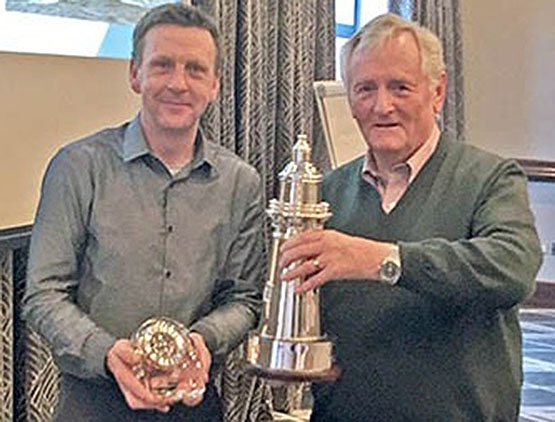
New ICRA Commodore Simom McGibney presents the “Boat of the Year” trophy to George Sisk of the Royal Irish Yacht Club, skipper of the Farr 42 WOW.
Work is going on behind the scenes to provide a strong defence this summer, but Anthony O’Leary wasn’t in Limerick to tell us about it, as he was away on his annual participation in America in the Viper 640 Championship, which just wouldn’t be the same if O’Leary wasn’t taking part - so much so that last year, he wasn’t present when his name came up as “Sailor of the Year” in Dublin, for he was away then too, Viper racing in the sun.
But other top sailors were there to round out the conference with the annual awards such as special performances by the likes of Dave Cullen with Checkmate XV and Ross Macdonald with Equinox and, while the ICRA Boat of the Year presentation, with warm acclamation, went to George Sisk of WOW, who not only admitted that his well-tested craft usually races with a crew of average age 53, but if he himself didn’t happen to be on board, the average age came down considerably………..And in case you think becoming ICRA Boat of the Year is all about glamour racing in sunshine, we close with a photo of WOW and the JPK 950 Alchimiste crawling towards the starting line for the Dun Laoghaire to Dingke race on the sort of damply windless evening that most folk would much prefer to spend comfortably at home.
It isn’t always glamour and warm sunshine and pleasant breezes. 2015 ICRA Boat of the Year WOW on a damp and windless evening approaching the start of the 280-mile Dun Laoghaire to Dingle race with the JPK 960 Alchimiste.
Foynes Yacht Club Laser Fleet Expands
It’s feast or famine with the wind these days at Foynes Yacht Club and after being blown out last weekend the possibility of getting a final days racing in the Reidy’s Centra Laser and Topper Series wasn’t looking promising as for much of the morning the River Shannon looked more like a sheet of glass than a sailing venue.
Racing was postponed until shortly after 1pm to allow the forecasted 8-10kts to build. The laser fleet continues to expand with another new junior sailor, Clara Shanahan, joining the racing today. OOD Vincent McCormack unusually brought the fleet west of Foynes Island which paid off as a nice breeze filled in albeit from the north and not SE as forecast and the race team managed to get in two windward-leeward races to conclude the series. The Junior Category was won by Dylan Reidy and the Senior Category by Cathal McMahon. Dinghy racing will continue next weekend with the March Laser and Topper Series starting next Sunday, 6th March.
Earlier this month four of Foynes newest and youngest boat owners took part in the week long optimist training camp in Baltimore. This is first time the club have had members taking part and the young sailors had a great week. Fresh with enthusiasm from the camp the oppie sailors, the fleet now up to six, took to the water to try out their newly acquired knowledge and skills. The future of the club is in good hands with these young sailors who fought off the cold with brave smiles for three very competitive races.
While winter projects continue in the yard the clubhouse is also getting plenty of use. This weekend the ISA had organised a Race Officer Level One Course at the Foynes venue. The course was given by National Race Officer Geoff O’Donoghue from Lough Derg Yacht Club and had a huge attendance with over 30 members from seven clubs along the west coast and the lakes taking part.
Next Saturday, 5th March, the Irish Cruiser Racing Association annual conference takes place in Limerick. The club are very proud to see one of their own members, Simon McGibney, take over the role of ICRA Commodore and would like to wish him every success in his tenure. The conference is on in the Castletroy Park Hotel from 10am and all cruiser sailors are welcome.
Shannon River Crossing Project to Install High-Voltage Cable
#Project - The "Shannon River Crossing" project is currently underway to install a high-voltage submarine cable linking counties on either side of the river.
The project conducted by ABCO Marine (Irl) Ltd aims to provide electricity between Kilpaddoge, Co Kerry and Moneypoint, Co Clare across the opposite banks along an underwater route of approximately 3km.
The project invloves the supply, installation and commissioning of a High Voltage Alternate Current (HVAC) comprising 21km of submarine cable. ABCO have mobilised the C57 Red Squirrel Jack Up Barge and workboats to support the marine trench excavation operations in support of the Kilpaddoge cable landings.
Currently ABCO's marine personnel, including support from ABCO Divers Ltd are on site completing the cable protection and marine trench backfilling operations. The site is challenging with significant tides as well as strong tidal currents, with all activities programmed and risk managed to maximise productivity whilst maintaining the highest H&S standards.
Commenting on the project, Brendan Osborne, ABCO's Marine Director, said: "We mobilised to the project in December to support the cable installation and marine trench excavation, the seasonal factors place increased risk on marine operations.
Our site team have excelled in the delivery of our operations to the clients satisfaction in a challenging and demanding work environment”.
Shannon Foynes Turnaround as 2015 Tonnages at Almost Peak of Last Decade
#ShannonGrowth - Tonnage growth at Ireland’s largest bulk port, Shannon Foynes Port Company (SFPC) revealed that the 2015 throughput was almost back to the peak of the last decade and this is evidence of the recovery taking hold in the regions.
SFPC handled just over 11.1m tons in 2015, up from just over 10.1million in 2014, and this comes off the back of a €2.8m profit recorded in its most recent annual accounts, for 2014. Tonnages in 2015 saw the company, which operates six ports on the Shannon Estuary and facilitates international trade valued at over €6bn, almost return to peak levels (11.35m tons) in 2006.
Announcing 2015 tonnages this week, SFPC said that the company is achieving the growth targets revealed three years ago with the launch of its masterplan, Vision 2041, and that this reaffirms the need for major investment in road and rail infrastructure to ensure its potential can be maximised. The tonnages also copper-fastens the company’s position as the largest dry bulk port in the country.
Cargo volumes last year at the SFPC general cargo terminals at Limerick and Foynes were particularly robust with 10.73% year on year growth. Among the key growth sectors were petroleum products tonnages, which increased by 7.4% and cement exports, which rose by over 200%. Agri related cargo also grew steadily, with trades such as fertilisers increasing by over 4%.
SFPC CEO Patrick Keating said, “This growth reflects the resurgence in the domestic and export economy and, of course, in our own business. SFPC is a really good economic indicator for the region. We had some challenging years but the turn-around in our business has been remarkable, to the extent that we are now almost replicating tonnages from the height of the last decade and expect to surpass those levels over the coming years.
“We are very confident about the potential of the Shannon Estuary as a major economic engine room for this region thanks to its unrivalled natural water depths. This year alone we have completed the biggest investment in quayside infrastructure in any Irish port so far this decade with the infill of our East Jetty, as part a wider €50m capital spend at Foynes. Our investment programme is also attracting significant private interest, with €40m in private investment also now coming on stream.”
SFPC Chairman Michael Collins also commenting on the port performance said, “SFPC is proving one of the great success stories of the recovery in this region. This impressive turnaround is very much down to a dynamic team and its determination to deliver the robust but attainable targets we have set for the company.
“Last year was another very solid year in terms of traffic throughput but future growth can only be sustained by delivering additional capacity and putting the road and rail infrastructure in place. If this doesn’t happen, the company’s potential to be a major engine for growth in this region will be curtailed.”
'Unprecedented Opportunity' for Shannon Foynes Port As Trade Hub
#FoynesPort - An “unprecedented opportunity" for Foynes Port and the Shannon Estuary to become a centre of international trade with the potential for up to 3,000 jobs in the coming years, reports The Limerick Leader.
That is according to MEP Sean Kelly who is urging the European Union to recognise the port’s strategic importance.
The Fine Gael MEP recently attended a meeting in Brussels with port company chief executive Pat Keating and the European Commission’s Mobility and Transport Directorate.
“Shannon Foynes is one of a limited number of terminals with deep water facilities in Europe - facilities that no other Irish port enjoys. With the Panama Canal set to double its capacity in 2016, there is an unprecedented opportunity for Europe and for Ireland to capitalise as Shannon Foynes can cater for the huge new vessels that will be coming through,” said Mr Kelly.
To read more about the mid-western seaboard port, click here.
Kilrush RNLI Launch in Gales to Assist 43ft Motor Vessel
Kilrush RNLI Lifeboat crew on the Shannon Estuary launched early this morning in gale force conditions to assist 43ft motor vessel that had fouled its propeller south of Moneypoint.
At 4.59am Shannon Coast Guard tasked Kilrush RNLI volunteer lifeboat crew to assist a motor vessel with 3 people on board that had lost engine power due to its propeller becoming fouled.
Kilrush lifeboat crew reached the scene at 5.20am and assessed the situation. It was apparent that the motor vessel was heavily fouled and in no immediate danger of drifting. Commercial divers were tasked as the sea state improved and managed to clear the propeller. Kilrush RNLI stood by until power was restored to the motor vessel and returned to station at 7.10am.
Commenting on the callout, Charlie Glynn, Kilrush RNLI Lifeboat Press Officer said: ‘Weather conditions were challenging but our volunteer crews are well prepared for every eventuality. This is a testament to the level of training and commitment from all at Kilrush RNLI.’
First Dividend Paid by SFPC Amid Record Profits
#FirstDividend - Enjoying its biggest ever profits last year, Shannon Foynes Port Company (SFPC) has revealed from their 2014 annual report.
SFPC, which operates six ports on the Shannon Estuary and handles international trade valued at over €6bn, saw profits increase to €2.864m from €2.825m in 2013.
The company’s general cargo terminals recorded year-on-year increases of 5 per cent and capitalised on the recovering economy through a GDP growth of over 4 per cent for 2014.
The growth now means the company is in a position to provide a dividend from the 2014 results. For more on the story, The Sunday Business Post reports here.
Foynes Yacht Club Reports a Busy October on the Shannon Estuary
For the first time in its fifty three year history Foynes Yacht Club ran an ISA Go Racing course at the club during the school October mid-term break. The course was fully booked out with ten participants from Foynes Yacht Club, Dingle Sailing Club, Cullaun Sailing Club and Lough Derg Yacht Club who gave up their mid-term break lie-in to complete the course under the guidance of club racing instructor Tadhg O’Loingsigh and two senior Instructors, Simon McGibney from Foynes Yacht Club and Feidhlim O’Briain from Dingle Sailing Club. The weather was ideal for the course with the participants getting afloat every day in conditions varying from 5 knots to +25 knots. The junior sailors also had opportunities to hear from Graham Curran from UK McWilliam Sailmakers and international race officer Jack Roy, both of whom visited the club during the week. Foynes Yacht Club's Sailing Academy Principal Patrick Finucane said that the sailing academy has been striving towards this for a number of years and was delighted with the success of the course.
The cruiser October series took place during the month with a six race series and fourteen boats taking part. Racing took place over five weekends concluding on the final Saturday in October. The series started in beautiful sunshine with 10-12kts westerly where OOD Vincent McCormack set the fleet off with an interesting spinnaker start and following a course round the cans on the estuary. The next few week’s courses returned to beat starts either round the cans or windward leeward. Conditions were mixed, always sunshine, but winds anywhere from 5kts to 15kts, the lighter conditions presenting quite a challenge to anyone eager to get ashore on time for the rugby matches! Congratulations to the winners 1st Maximus from FYC, 2nd Scorpio Junior from Lough Derg, 3rd Powder Monkey from TBSC.
Junior and senior competitors after the ISA Go Racing course
The Laser and Topper fleet are back on the water again for the winter starting with a very successful October Series with nineteen boats taking part over the five weekends and nine out of the ten scheduled races taking place. Congratulations to the series winners in the senior fleet 1st Simon McGibney, 2nd Mark McCormack, 3rd Michael McGowan and in the junior fleet 1st Dylan Reidy, 2nd Mary McCormack, 3rd Oisín Finucane. The Laser and Topper November Series will begin next weekend and run on Sunday afternoons for the next four weeks.
#foynesairshow – One of the largest search and rescue (SAR) training exercises ever undertaken in Ireland will open the 2015 Foynes Air Show on Sunday, 26th July.
The Irish Air Corps, Naval Service (LÉ Samuel Beckett), Irish Coastguard, and Search and Rescue teams from all over the country will carry out their annual exercise in front of the estimated 15,000 people expected to attend the second annual air show.
Hosted by Foynes Flying Boat & Maritime Museum, the Air Show will also feature aircraft displays from across Europe, along with some of the world's top aerobatic pilots.
Among the aircraft taking to the skies over West Limerick and the Shannon Estuary will be a Russian Mini MiG, authentic World War Two aeroplanes, a Hawker Hunter fighter, a P51 Mustang and James Bond's BD-5 Micro-Jet. Meanwhile, Aer Lingus' first plane, the Iolar, will be flying in formation for one of the first times ever at a public display with three de Havilland Chipmunks in Air Corps colours.
The Air Show will also feature the world's only formation wingwalking display team, The Breitling Wingwalkers who will perform a sequence of formation loops and rolls while wingwalkers perform acrobatics on the wings.
The Air Show, which gets underway at 1pm and continues until 6pm, will also feature live music, food stalls and children's entertainment. Organisers say that Park and Ride services will be provided throughout the event to enhance access to and from the Air Show site
The Foynes Air Show was first held in 2014 when the Foynes Flying Boat & Maritime Museum marked the 75th anniversary of the first transatlantic commercial passenger flight that took place to the Flyingboat base, located 23 miles from Limerick City.
"We look forward to hosting a thrilling and exciting Air Show of an international standard which will feature even more aircraft and participants than our hugely successful inaugural show in 2014," commented Margaret O Shaughnessy the Director of Foynes Flying Boat & Maritime Museum.
"Foynes has a strong association with international aviation and has the world's only Flying Boat Museum featuring the world's only replica of B314 flying boat. The Air Show not only provides a wonderful day out for aviation enthusiasts and people of all ages but it also celebrates Foynes' historic place in world aviation history," she added.
Gerry Humphreys, Foynes Air Show Director said: "We are very excited to bring this free air show to Foynes again this year. We would like to thank our many sponsors without whose support this event would not be possible."
Aircraft taking part in the 2015 Foynes Air Show include:
Cold War Russian Aircraft - The Somerset-based Yakovlevs will perform a specialist airborne display team flying authentic cold war Russian war-bird aircraft in precise combinations of tight formations and aerobatics, high-speed passes and crosses.
BD5 - Made famous in the opening sequence of the James Bond film, Octopussy, the BD5 is a single-seat homebuilt aircraft created in the late 1960s by US aircraft designer Jim Bede
Sukhoi Su-26 - A single-seater aerobatics plane from the former Soviet Union, flown by ond of Ireland's top aerobatic pilots and engineers Dave Bruton
Hawker Hunter - A UK jet fighter flown by highly experienced former RAF Harrier pilot and Airbus Captain Andy Hill
Christen Eagle - Described as a true sports car of the sky, the 2-seat Eagle flown by Andrew Fenton will perform aerobatics
CAP 231 – Top Aerobstic Pilot Eddie Goggins "The Flying Dentist" returns to Foynes to fly an aircraft designed for competition aerobatics
Aviatika-MAI-890 (Mini-MiG) – 21 year old Pilot Harry Humphreys will fly his Aviatika-MAI-890, a pod-and-boom, pusher configuration biplane designed and built by the Moscow Aviation Institute (MAI) in Russia in the 1980s
RV4/8 - UK-based Team Raven will perform a 5-ship RV4/8 Aerobatic formation display
Vans RV7 - Gerry Humphreys and Eddie Goggins, known collectively as AerDynamics, are the first ever Irish civilian aerobatic formation team and will be flying the versatile Vans RV7 and the Cap 231 in a unique display of low level formation aerobatics and exciting head-on passes.
Killorglin based Approved Productions are the event managers for the upcoming Air Show, which is being supported and sponsored by Limerick City and County Council, The Irish Aviation Authority (IAA), Avolon, Wild Atlantic Way, Shannon Foynes Port Company, Irelandia Aviation, AerCap, Air Contractors, Rusal Aughinish and CPL Fuels.



























